Maharashtra Board Class 12 Solutions for Biology Chapter 4 Molecular Basis of Inheritance – Download Free PDF with Solution
We have studied how genetic information passes from one generation to the other. It is the DNA content of the chromosomes that are transferred from the parent to the offspring generation via sexual and asexual reproductive methods. Chapter 4 of Class 12 Biology will explain the Molecular Basis of Inheritance and will explain how this phenomenon happens.
To make this chapter easier to prepare, find the solutions to all the exercises of this chapter along with its notes. Get the best answers formulated by the top experts of Vedantu and clarify doubts on your own.
Access Maharashtra Board Solutions for Biology Class 12 Chapter 4 Molecular Basis of Inheritance
Multiple Choice Questions
1. Griffith worked on …………
Bacteriophage
Drosophila
Frog eggs
Streptococci
Ans: The correct answer is option (d) Streptococci.
Griffith worked on Streptococci bacteria and his experiment showed that there is a genetic material that can be transferred from bacteria by the process of transformation. He called the genetic material a transforming principle.
2. The molecular knives of DNA are …………….
Ligases
Polymerases
Endonucleases
Transcriptase
Ans: The correct option is (c) Endonucleases.
The enzymes that break the internal bonds of a nucleotide chain and thus, convert the nucleotide chain into two or more nucleotide chains are called endonuclease. In DNA, the endonuclease breaks the phosphodiester bond. Some endonucleases cut the DNA sequences at specific locations while some endonucleases are non-specific.
3. Translation occurs in the …………..
Nucleus
Cytoplasm
Nucleolus
Lysosomes
Ans: The correct option is (b) Cytoplasm.
After the transcription process that occurs in the nucleus, the mRNA is transferred into the cytoplasm of the cell where tRNA and ribosomes act on it and translate the mRNA into proteins. Hence, the synthesis of proteins takes place in the cytoplasm.
4. The enzyme required for transcription is ……………
DNA polymerase
RNA polymerase
Restriction enzyme
RNAse
Ans: The correct option is (b) RNA polymerase.
In the transcription process, the complementary strand of mRNA is formed with the help of a template DNA strand in the nucleus of the cell. The enzyme involved in the transcription process is RNA polymerase which adds ribonucleotides for the formation of mRNA strands.
5. Transcription is the transfer of genetic information from …………..
DNA to RNA
tRNA to mRNA
DNA to mRNA
mRNA to tRNA
Ans: The correct option is (c) DNA to mRNA.
In the process of transcription, the genetic material is transferred from DNA to mRNA in the presence of an RNA polymerase enzyme that adds the ribonucleotides to form an RNA strand that is complementary to the single-stranded template DNA strand.
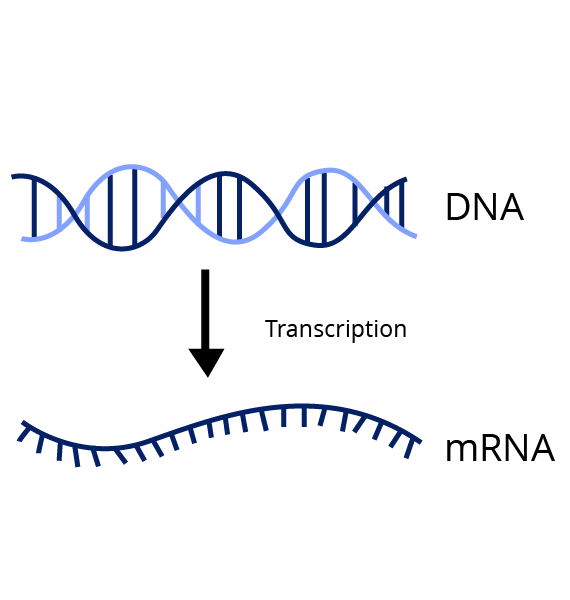
Transcription Process
6. Which of the following is NOT part of protein synthesis?
Replication
Translation
Transcription
All of these
Ans: The correct option is (a) Replication.
Two main processes are involved in the synthesis of proteins. These are transcription and translation. The mRNA molecule that is synthesised in the nucleus during transcription is released into the cytoplasm. In the cytoplasm, the proteins are synthesised using mRNA by the process of translation.
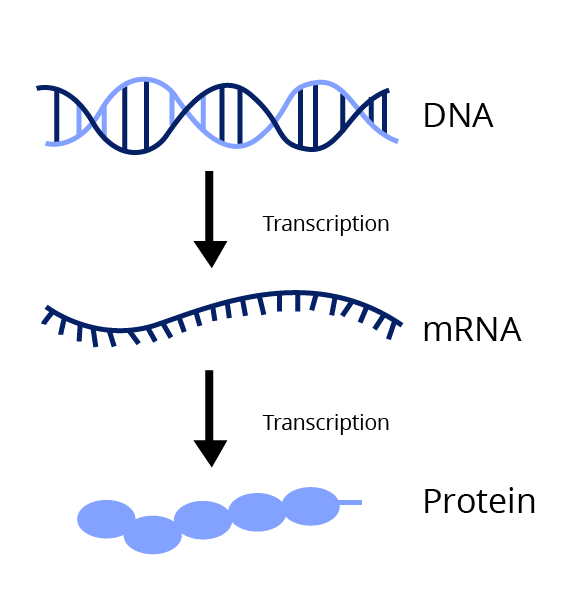
Steps in Protein Synthesis
7. In the RNA molecule, which nitrogen base is found in place of thymine?
Guanine
Cytosine
Thymine
Uracil
Ans: The correct option is (d) Uracil.
Both DNA and RNA contain four nitrogenous bases. But, in RNA, uracil is present in place of thymine. However, just like thymine pairs with adenine in DNA, the uracil pairs with adenine in RNA. All the other three nitrogenous bases (adenine, guanine and cytosine) are present in both DNA and RNA.
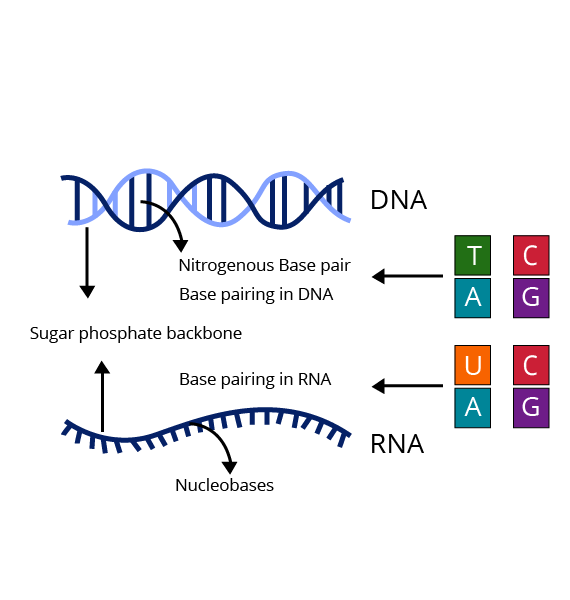
Structure of RNA and DNA
8. How many codons are needed to specify three amino acids?
3
6
9
12
Ans: The correct option is (a) 3
As we know that each codon codes for a specific amino acid. Hence, to specify the three amino acids, three codons are required. Three nucleotides make up one codon.
9. Which of the following is not an example of an inducible operon?
Lactose operon
Histidine operon
Arabinose operon
Tryptophan operon
Ans: The correct option is (d) Tryptophan operon.
An inducible operon is the one that turns on in the presence of an inducer and then transcription occurs. The inducer either inactivates the repressor or stimulates the activator protein. Lactose, histidine and arabinose are examples of inducible operons while tryptophan is an example of a repressor operon.
10. Place the following event of translation in the correct sequence
Binding of met-tRNA to the start codon.
Covalent bonding between two amino acids.
Binding of the second tRNA.
Joining of small and large ribosome subunits.
iii, iv, I, ii
i, iv, iii, ii
iv, iii, ii, i
ii, iii, iv, I
Ans: The correct option is (B) i, iv, iii, ii.
The translation involves the following three stages:
Initiation: In this stage, the small subunit of ribosome gets attached to the start of mRNA and then methionine containing tRNA or met-tRNA binds to the start codon of the sequence of mRNA. When a large subunit of the ribosome attaches to the start of the mRNA sequence, the initiation complex is formed.
Elongation: In this stage, the translation of codons is done by ribosomes one by one. Amino acids are added and joined by a peptide bond. The elongation continues till all the codons are not read.
Termination: In this stage, termination of protein synthesis occurs when the ribosomes arrive at a stop codon.
Very Short Answer Questions.
1. What is the function of an RNA primer during protein synthesis?
Ans: RNA primer plays an important role during the replication of DNA. It helps the DNA polymerase enzyme to start the replication process by providing nucleotides to it to add them to the existing strand of DNA. The RNA primer has a base sequence complementary to the existing DNA strand.
2. Why is the genetic code considered as comma less?
Ans: The genetic code is present as a continuous triplet code on the mRNA sequence. There is no gap, comma or punctuation mark between the consecutive triplet codons and hence, genetic code is considered as comma less.
3. What is the genome?
Ans: An organism's genome is the set of all the nucleotide sequences of DNA present in the organism. The genome contains all the important information required by the organism to work effectively.
4. Which enzyme does remove supercoils from replicating DNA?
Ans: Topoisomerases are the enzymes that remove the supercoils from the replicating DNA strand. During the replication of DNA, due to the helical structure of DNA, supercoils are formed. This is removed by the action of the topoisomerase enzyme.
5. Why are Okazaki fragments formed on lagging strands only?
Ans: The leading strand synthesised the DNA strand continuously while the lagging strand synthesises the DNA strand discontinuously during the replication of DNA. The DNA polymerase enzyme can synthesise the new DNA from the lagging strand in a 5' to 3' direction only. Due to the discontinuous nature of the lagging strand, the short fragments formed on the lagging strand are called Okazaki fragments. This helps in the formation of two daughter strands.
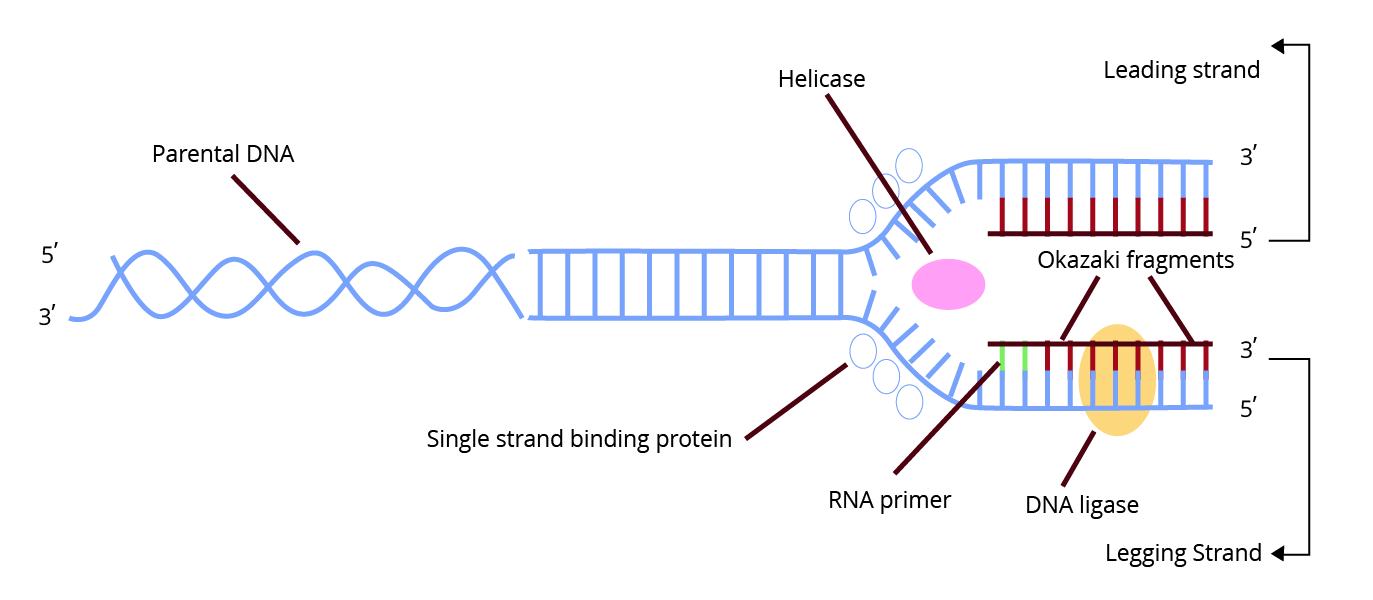
Okazaki Fragments on Lagging Strand
6. When does DNA replication take place?
Ans: DNA replication or formation of two similar molecules of DNA takes place during the synthesis phase (also called the S-phase) of the cell cycle. The enzyme helicase is responsible for unwinding the double helix DNA. This results in the formation of two single DNA strands that act as templates to synthesise new daughter DNA strands.
7. Define the terms- codon and codogen.
Ans: The given terms are defined below:
Codon: Codon is a set of any three consecutive nucleotides present on the mRNA molecule that codes for a specific amino acid.
Codogen: Codogen is the smallest possible set of nucleotides present on the DNA that code for a particular amino acid. Like codons, the codogen is also a triplet.
8. What is the degeneracy of the genetic code?
Ans: Generally, one codon codes for a specific amino acid. But, some amino acids are coded by more than one codon. This is called the degeneracy of genetic code which was explained by the Wobble hypothesis.
9. Which are the nucleosomal 'core' histones?
Ans: The nucleosomal 'core' histones are responsible for the tight packaging of DNA. This tight packaging of DNA ensures the exact transfer of genetic material from generation to generation without any error. Four nucleosomal 'core' histones form one nucleosome. These are H2A, H2B, H3 and H4.
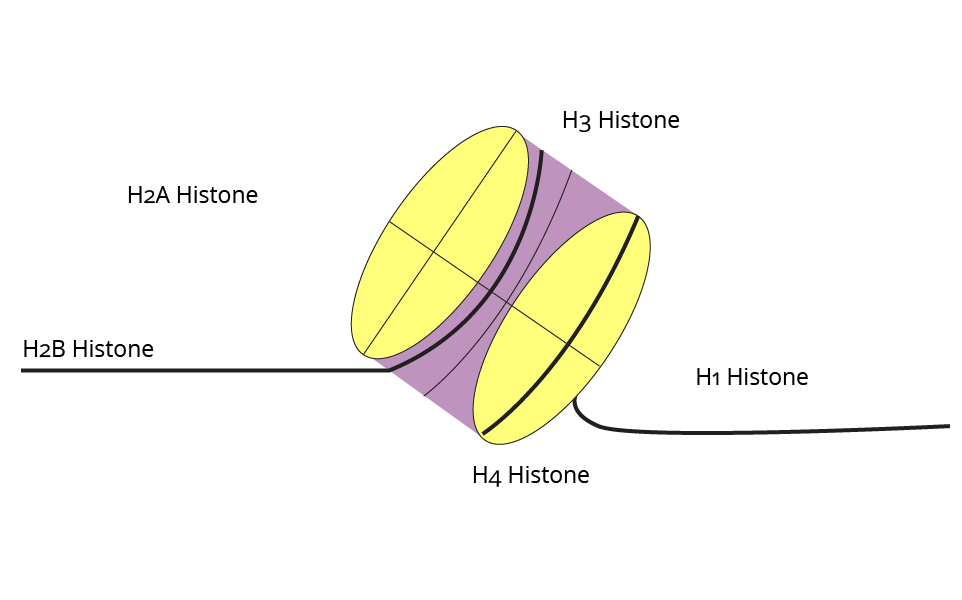
Nucleosomal ‘Core’ Histones
Short Answer Questions
1. Write a short note on DNA packaging in the eukaryotic cells.
Ans: The DNA packaging in the eukaryotic cells is explained below:
In eukaryotic cells, the DNA is properly packaged inside the nucleus of the cell with the help of special proteins called histone proteins.
The negatively charged DNA molecule is wrapped around eight histone proteins forming a nucleosome.
Now, this nucleosome complex forms the thread-like structures called chromatin that properly fit inside the nucleus.
This tight packaging of DNA ensures the exact transfer of genetic material from generation to generation without any error.
2. Enlist the characteristics of the genetic code.
Ans: The characteristics of the genetic code are given below:
The genetic code is present as a continuous three nucleotides on the mRNA sequence. The genetic code is therefore triplet.
Each triplet or codon code for a particular amino acid. Hence, the genetic code is unambiguous.
There is no gap, comma or punctuation mark between the consecutive triplet codons and hence, genetic code is considered as comma less.
Generally, one codon codes for a specific amino acid. But, some amino acids are coded by multiple codons. Hence, the genetic code is called redundant or degenerate.
In almost all organisms, the same codon codes for the same amino acid. Hence, the genetic code is universal.
3. Write a note on applications of DNA fingerprinting.
Ans: The applications of DNA fingerprinting are:
Criminal Investigations: The biological evidence such as hair, nails, fingerprints etc. from the crime scenes are matched with the crime suspects. The forensic doctors match the DNA from evidence with the DNA of suspects.
Parental Testing: DNA fingerprinting is also used to identify the biological parents of a child.
Evolutionary Relationships: DNA fingerprinting also establishes an evolutionary relationship by comparing the DNA of various organisms.
4. Explain the role of lactose in 'Lac Operon'?
Ans: Lactose plays a very important role in transcription. It binds to the repressor protein and thus, acts as an inducer in Lac Operon. The inducer either inactivates the repressor or stimulates the activator protein. The lactose acts as an inducer by inactivating the repressor protein and thus, the RNA polymerase can now easily bind to the promoter site and start the transcription process.
5. Write a note on the Human Genome Project (HGP).
Ans: Human Genome Project is explained below:
Human Genome Project was an international scientific project that was completed in the year 2003.
The project involves the studying, sequencing and mapping of the entire genes present in humans.
The major goals of the HGP are to create databases and analyse them by creating advanced tools.
The project became the basis of major development in bioinformatics.
The project can help to find the solution to many genetic disorders that arise in humans.
6. Describe the structure of 'Operon'.
Ans: The structure of the operon is described below:
The operon is involved in the transcription process.
There are mainly three parts of operon- promoter, operator and structural genes. The promoter and operator are called control elements as they control the transcription process.
The promoter is the region where RNA polymerase binds and starts transcription. Thus, the promoter is the region for the synthesis of RNA.
The operator is the region where repressor proteins bind and stop transcription.
The regulator genes are responsible for the formation of repressor proteins to bind at the operator site and thus, stop the transcription process.
The structural genes contain genes that code for protein present in the genome of an organism.
7. In the figure below A, B and C are three types of ______________.
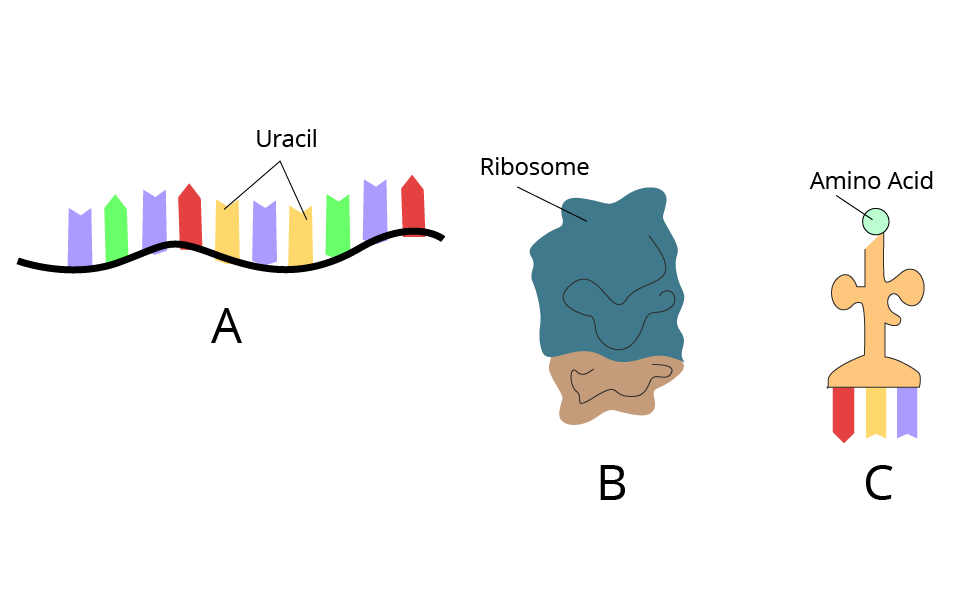
Types of RNA
Ans: A, B and C are three types of RNA.
A represents the molecule whose sequence contains the base pair uracil. Uracil is present in the mRNA instead of thymine which is present in DNA.
The B represents the ribosome-containing configuration that is present in the ribosomal RNA or rRNA.
The C represents the structure containing amino acid at its one end. The amino acid is attached at the amino acid attachment site of tRNA during the translation process.
8. Identify the labelled structures on the following diagram of translation.
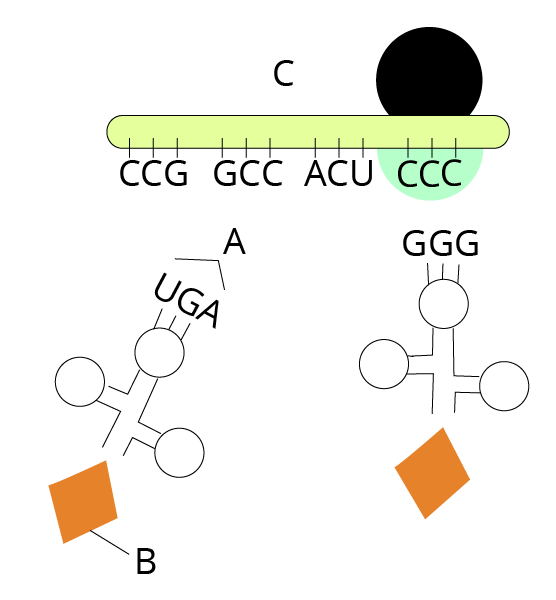
Translation
Part A is the _____________
Part B is the _____________
Part C is the _____________
Ans: The answers are explained below:
Part A is the anticodon: An anticodon is a sequence containing three nucleotides that resemble the complementary codon present in the mRNA sequence.
Part B is the amino acid: During the process of translation, the ribosome binds to the mRNA sequence and reads the code. Accordingly, the ribosomes add the amino acids and thus, the synthesis of proteins takes place.
Part C is the large ribosomal subunit.
There are two subunits of ribosomes- a large ribosomal subunit and a small ribosomal subunit. During the initiation phase of translation, the small subunit of ribosome gets attached to the start of mRNA and then methionine containing tRNA or met-tRNA binds to the start codon of the sequence of mRNA. When a large subunit of the ribosome attaches to the start of the mRNA sequence, the initiation complex is formed.
9. Match the entries in column I with those in column II and choose the correct answer.
Column I | Column II |
| i. Separation of DNA fragments on gel slab |
| ii. Split DNA fragments into single strands |
| iii. DNA transferred to a nitrocellulose sheet |
| iv. X-ray photography |
| v. Produce fragments of different sizes |
| vi. DNA amplification |
Ans: The correct matches are given below:
Column I | Column II |
| ii. Split DNA fragments into single strands When DNA is treated with strong alkalies such as sodium or potassium hydroxide, the double helix DNA splits into two single strands. This is also called DNA denaturation. |
| iii. DNA transferred to a nitrocellulose Southern blotting is a molecular biology technique that is used for the detection of a specific sequence or gene in a DNA molecule. The technique involves the transfer of DNA molecules to a nitrocellulose membrane to absorb the DNA from agarose gel. |
| i. Separation of DNA fragments on gel slab Electrophoresis is a molecular biology technique that involves the separation of macromolecules such as DNA fragments, RNA, proteins etc. on a gel slab based on size. |
| vi. DNA amplification PCR or Polymerase Chain Reaction is a technique in which DNA is multiplied or amplified many times. Millions of copies of DNA are made using the PCR technique. The technique is very useful for the detection of infections or small changes in the DNA molecule. |
| iv. X-ray photography Autoradiography is an analytical technique in biology that uses X-ray film to detect the molecules or compounds that are labelled radioactive. |
| v. Produce fragments of different sizes In molecular biology, the REN or restriction enzymes are molecular scissors that cut the DNA at specific locations to produce DNA fragments of different sizes. |
Long Answer Questions
1. Explain the process of DNA replication.
Ans: DNA replication or formation of two similar molecules of DNA takes place during the synthesis phase (also called the S-phase) of the cell cycle. The manner of DNA replication includes the subsequent steps:
Initiation: The replication starts at the region of DNA called the origin of replication. During the initiation phase, the unwinding of double helix DNA takes place. The enzyme helicase is responsible for unwinding the double helix DNA. This results in the formation of two single DNA strands that act as templates to synthesise new daughter DNA strands.
Elongation: During the elongation phase, the Okazaki fragments are formed because of the unidirectional nature of DNA polymerase. It can synthesise the DNA strand in 5'to 3' direction. Thus, two strands are formed, one is the leading strand which is continuous and the other is the lagging strand which is discontinuous. The enzyme ligase joins the Okazaki fragments.
Termination: In this phase, the newly synthesised strands are proofread by enzymes. Once this is done, the parental strand and newly synthesised strand are coiled to form a double helix DNA strand. Thus, after the replication of DNA, two molecules of DNA are formed.
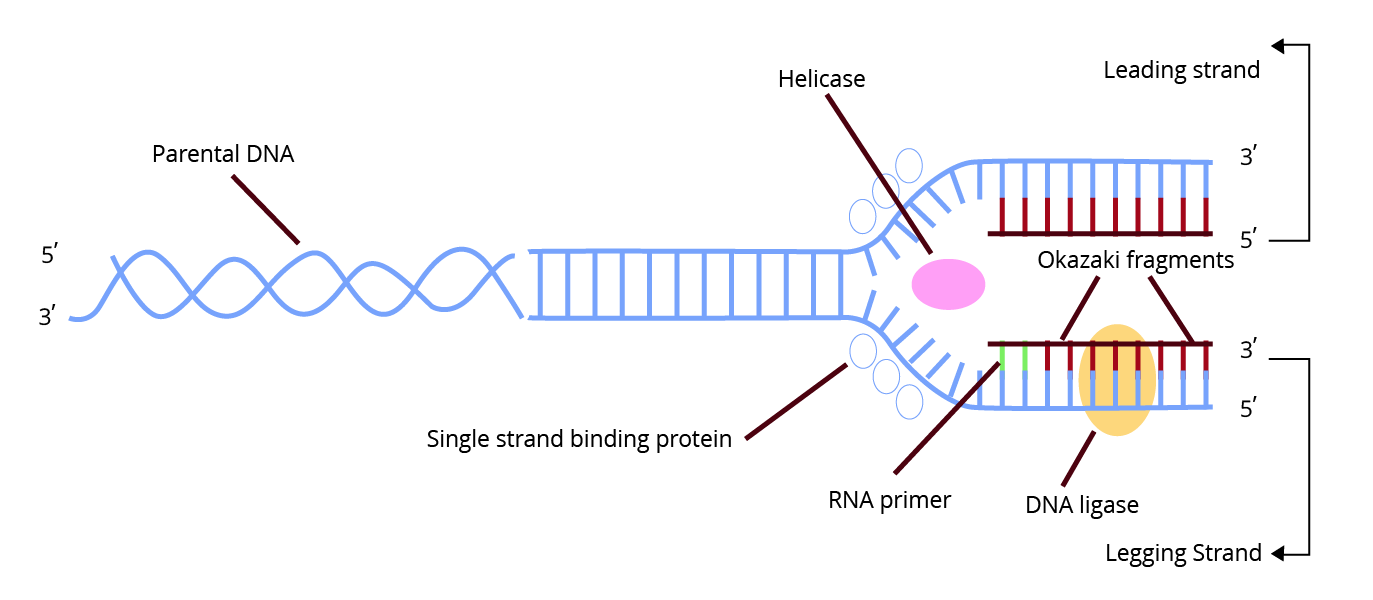
Replication of DNA
2. Describe the process of transcription in protein synthesis.
Ans: In the process of transcription, the genetic material is transferred from DNA to mRNA in the presence of an RNA polymerase enzyme. The transcription process involves the following stages:
Initiation: During the initiation phase, the RNA polymerase enzyme binds to the promoter region of the DNA strand. Once the RNA polymerase binds to the promoter, the Double helix DNA starts unwinding. This results in the formation of two DNA strands that act as a template for the new mRNA sequence.
Elongation: During this phase, the ribonucleotides are added to form an RNA strand that is complementary to the single-stranded template DNA strand.
Termination: When the RNA polymerase enzyme reaches the terminator sequence on the DNA strand, the transcription stops and mRNA is released from the template strand.
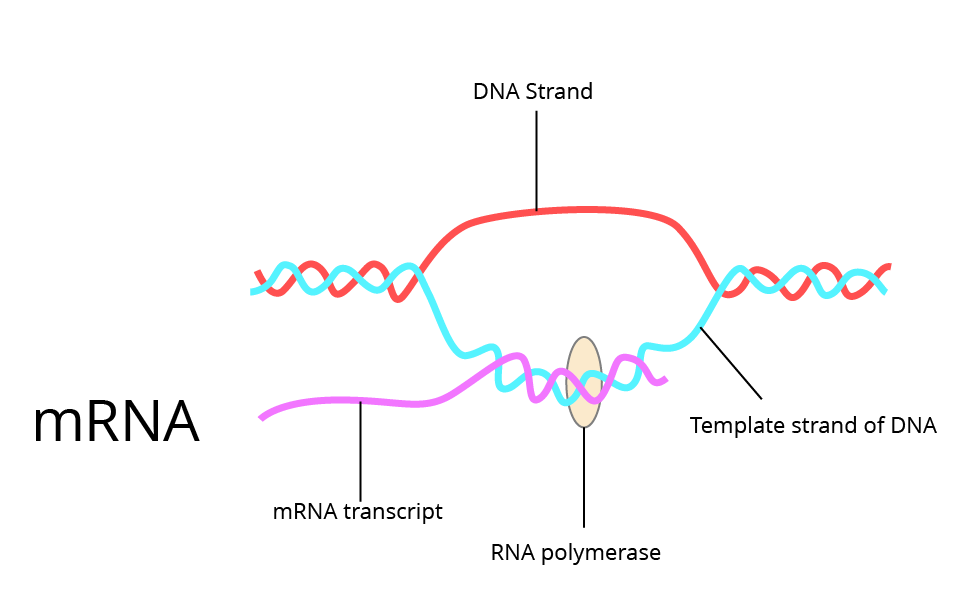
Transcription Process in Protein Synthesis.
3. Describe the process of translation in protein synthesis.
Ans: Two main processes are involved in the synthesis of proteins. These are transcription and translation. The mRNA molecule that is synthesised in the nucleus during transcription is released into the cytoplasm. In the cytoplasm, the proteins are synthesised using mRNA by the process of translation. The translation process involves the following stages:
Initiation: In this stage, the small subunit of ribosome gets attached to the start of mRNA and then methionine containing tRNA or met-tRNA binds to the start codon of the sequence of mRNA. When a large subunit of the ribosome attaches to the start of the mRNA sequence, the initiation complex is formed.
Elongation: In this stage, the translation of codons is done by ribosomes one by one. Amino acids are added and joined by a peptide bond. The elongation continues till all the codons are not read.
Termination: In this stage, termination of protein synthesis occurs when the ribosomes arrive at a stop codon.
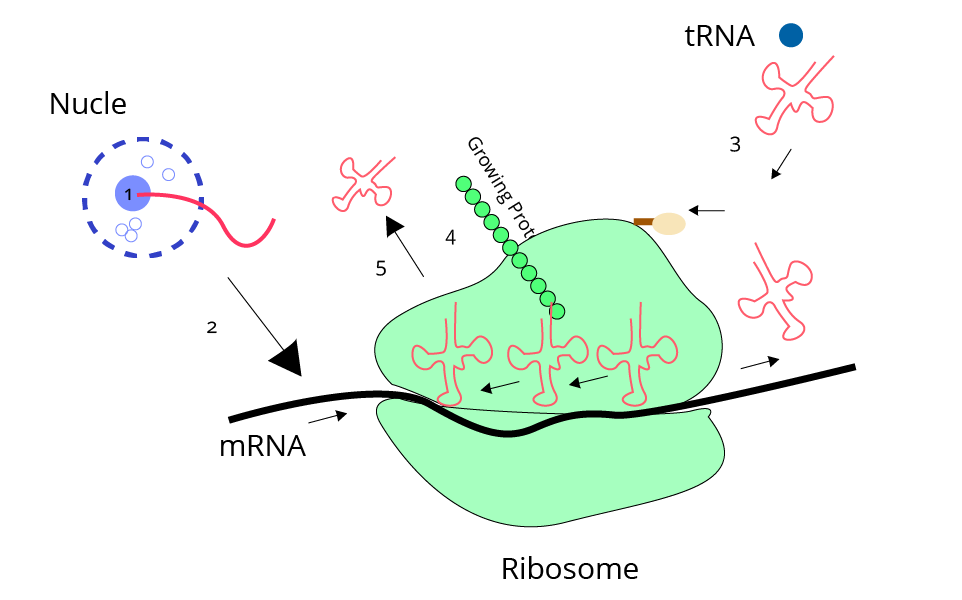
Translation Process in Protein Synthesis.
4. Describe the 'Lac-Operon'.
Ans: Lac-operon is described below:
Lac-Operon is a group of genes that code for proteins that help in lactose metabolism in bacteria.
The Lac-Operon consists of a promoter, an operator, three structural genes called lac A, lac Z, and lac Y, and one regulator gene that codes for a repressor protein.
The genes of Lac-Operon are expressed in the presence of Lactose. However, the genes are not expressed in the presence of glucose.
lac A codes for the transacetylase enzyme, lac Y codes for permease while lac Z codes for galactosidase enzyme.
Lac Operon also contains a promoter where RNA polymerase binds and starts transcription when glucose levels are low.
When the lactose level is high, the repressor proteins do not function. The lactose binds to the repressor and thus, prevents the binding of repressor protein to the operator region.
5. Justify the statements. If the answer is false, change the underlined word (s) to make the statement true.
The DNA molecule is double-stranded and the RNA molecule is single-stranded.
The process of translation occurs at the ribosome.
The job of the mRNA is to pick up amino acids and transport them to the ribosomes.
The transcription must occur before translation may occur.
Ans:
a. This is a true statement.
The double-stranded nature of DNA molecules is stable and thus, ensures the tight packaging of genetic material. On the other hand, the double-stranded RNA is unstable. It is generally present as a single-stranded molecule and is also involved in various functions.
b. This is a true statement.
After the transcription process that occurs in the nucleus, the mRNA is transferred into the cytoplasm of the cell where ribosomes act on it and translate the mRNA into proteins. Hence, the translation process occurs on the ribosomes.
c. This is a wrong statement.
The tRNA is involved in picking up amino acids and transporting them to the ribosomes. The ribosomes then add the amino acids similar to the corresponding three nucleotides present on the mRNA sequence.
d. This is a true statement.
For the translation to occur, there must be an mRNA sequence. The mRNA is formed by the transcription process. After the transcription process that occurs in the nucleus, the mRNA is transferred into the cytoplasm of the cell where tRNA and ribosomes act on it and translate the mRNA into proteins.
6. Guess (i) the possible locations of DNA on the collected evidence from a crime scene and (ii) the possible sources of DNA.
Evidence | Possible Locations of DNA on the Evidence | Sources of DNA |
e.g. Eyeglasses | e.g. Earpieces | e.g. Sweat, skin |
Bottle, can, glass | Sides, mouthpiece | …..………….. |
…………………. | Handle | Sweat, skin, and blood |
Use cigarette | Cigarette butt | ………………… |
Bite mark | …………………. | Saliva |
…………………. | Surface area | Hair, semen, sweat, urine |
Ans: The answers are given below:
Evidence | Possible Locations of DNA on the Evidence | Sources of DNA |
e.g. Eyeglasses | e.g. Earpieces | e.g. Sweat, skin |
Bottle, can, glass | Sides, mouthpiece | Saliva, sweat |
Any sharp object that can be used as a weapon, doors, cupboard | Handle | Sweat, skin, blood |
Use cigarette | Cigarette butt | Saliva |
Bite mark | Body of person and clothes. | Saliva |
Used clothes, pillow, comb, towel, used condom | Surface area | Hair, semen, sweat, urine |
Importance of Class 12 Biology Chapter 4 Molecular Basis of Inheritance
Heredity is one of the crucial topics of biology taught at the higher secondary level in the Maharashtra Board. In this chapter, you will get knowledge related to how genetic information is coded and transferred to the progeny at the molecular level.
This chapter will introduce and define what DNA and RNA mean. You will also find out where these complex units of genetic material reside and how they are formed. It will also teach how information is coded and passed from one generation to the other. It is a very complex process yet every reproductive process transmits information so accurately.
The history of the discovery of genetic material will also be explained in this chapter. You will also learn the biological features of these genetic materials. The composition of DNA, RNA, and nucleon vary.
The experiments related to the discovery and theorisation of the functions of genetic material will also be explained. The fascinating facts about Molecular Biology in this chapter will provide immense insights. These concepts will then be used to answer the fundamental questions of the chapter exercises. Refer to the Molecular Basis of Inheritance exercise solutions to find out the right answers.
Benefits of Maharashtra Board Class 12 Biology Notes Chapter 4 Molecular Basis of Inheritance
The notes are designed by the top subject experts. They have a clear idea of the concepts and know how to explain them in a simpler version. It will help you to learn and understand these fundamental concepts related to the molecular biology of heredity or inheritance.
You can save time by finding out the right answers to the exercise questions. Hence, you can take a step ahead in your preparation for this chapter.
Resolve doubts on your own and make the preparation of this chapter faster. With proper utilization of your time, you can proceed to complete other chapters in the Class 12 Biology syllabus.
Download Molecular Basis of Inheritance Class 12 Notes PDF Maharashtra Board
The notes and solutions are available in a free PDF version. You can download them and add the files to your study material. Make your study sessions more fruitful. Learn from the Molecular Basis of Inheritance Class 12 notes compiled by the experts and revise this chapter faster. Use the simpler version of all the concepts of the Molecular Basis of Inheritance chapter to remember and recall. Follow how the experts have skillfully answered all the questions and scored well in the exams.
FAQs on Maharashtra Board Class 12 Solutions for Biology Chapter 4 Molecular Basis of Inheritance
1. What is DNA?
DNA stands for deoxyribonucleic acid. It is the unit of the genetic material present in the genes of chromosomes of living organisms.
2. What is RNA?
It stands for ribonucleic acid. It is present in all living cells. It acts as the messenger of DNA to control the synthesis of proteins. It also acts as genetic material in some viruses and primitive organisms.
3. What is inheritance?
The biological phenomenon where the characteristic traits of parents are passed to the offspring is called inheritance.
4. What is a nucleus?
The dark portion of a cell where the genetic material is stored is called the nucleus. It contains the chromosomes that control every function of a cell.
5. What is genetic material?
The material that contains the genetic information of an organism is called its genetic material.

















